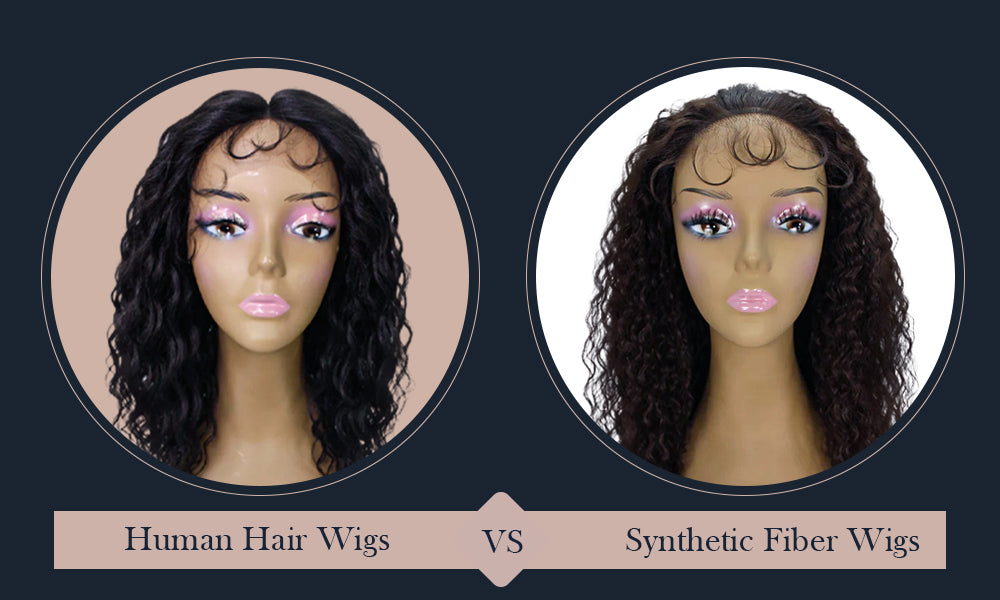Human Hair Wigs vs Synthetic Fiber Wigs — Which Ones are Better?

Wigs are quickly becoming a staple in the beauty world, and for good reason. Want luscious long locks? They have you covered. Ready to rock a cute bob? They can do that too! Wigs aren't just for hiding a bad hair day; they're for showing off your style and easily switching up your look, all while protecting your natural hair.
While wearing wigs hasn't always been popular, it’s now shown that around 50% of Americans use wigs or other hair extensions, and the number is even higher amongst celebrities at a whopping 90%! That brings us to the ultimate question – what are all of these wigs made of?
The two most popular types of wigs are human hair wigs and synthetic fiber wigs. While the purpose and use of these wigs are largely the same, there are some key differences in product use and quality. Below we’ll guide you through some of the most frequent confusions and answer the question once and for all: which one is better, human hair wigs or synthetic fiber wigs?
Human Hair Wigs
As the name implies, Human Hair Wigs are made of human hair. With most wig manufacturers only accepting healthy virgin hair, these wigs are naturally soft, shiny, and heat styleable. They can be combed and washed, used with product, and even trimmed! However, it's important to note that Human Hair Wigs typically fall under two distinct categories: Human Hair and Remy Hair.
-
Human Hair Wigs
Human Hair Wigs are made from 100% human hair, meaning that you can typically do everything to them that you do to your natural hair – heat style, cut, wash, dye, blow-dry, and accessorize. The styling possibilities of a regular Human Hair Wig are just as thrilling as if the hair were your own, but it can also include the same amount of work. Unlike synthetic fiber wigs, human hair doesn’t snap back into its original style, meaning it needs to be restyled after each and every wash.
-
REMY Human Hair Wigs
Remy Hair Wigs are the crème de la crème of the wig world. Made from the finest quality human hair, Remy refers to the distinct method of collecting and assembling the human hair. Remy hair is collected from a single donor and is carefully selected to ensure that all the cuticles are aligned in the same direction. This means the hair looks more natural and is less prone to tangling. The careful process of cutting the hair from the donor and manufacturing it makes Remy Wigs more expensive, but it may be worth it for a more natural, smooth look.
While these two categories make the biggest difference in price and quality, other specifics, like the origins of the hair, also make a difference. There's Asian Hair, Indian Hair, Brazilian Hair, European Hair – the list goes on! As if that weren't enough, all of these types can be considered virgin (hair that has never been dyed or chemically treated) or non-virgin (hair that may have been dyed, bleached, or permed to create its look).
Take a look at the pros and cons of a Human Hair Wig:
| Human Hair Pros | Human Hair Cons |
|---|---|
|
|
Synthetic Fiber Wigs
The most affordable hair on the market is synthetic fiber hair. These wigs are made of a variety of man-made fibers, such as acrylic, polyester, PVC, and kanekalon. The quality depends on the type of hair fiber used, with the most luxurious being kanekalon. High-quality Synthetic Fiber Wigs can replicate the appearance and feel of natural human hair, and can be pre-styled into braids, locs, curls, and ever-more! Think bold colors, fashionable styles, and out-of-this-world volume – Synthetic Fiber Wigs can do it all. These wigs allow you to experiment with different looks at a more affordable price, and can even be heat-styleable for maximum customization.
While a synthetic fiber wig is much more affordable than a human hair wig, there are some things to look out for. Many synthetic styles aren’t made for heat styling, and the fibers aren’t quite as long-lasting as human hair. They're not suitable for bleaching or dyeing, so the color you get is the color you’re stuck with. However, they're a great option for experimenting, and you get to enjoy an easy pre-styled look that snaps back into place after a gentle wash.
Take a look at the pros and cons of a Synthetic Fiber Wig:
| Synthetic Fiber Pros | Synthetic Fiber Cons |
|---|---|
|
|
Human Hair Wigs vs Synthetic Fiber Wigs — which one is better?
In terms of quality and the most natural look and feel, human hair wigs take the cake. But when it comes to experimenting with a variety of styles at a low cost, synthetic fibers come out on top. It all depends on your lifestyle and preferences – do you want one everyday wig that you can style, or a variety of locs, curls, and braids? Do you enjoy heat styling your hair or do you want a wig that maintains a pre-styled look? Whatever your answer, rest assured; the perfect wig is out there for you.





